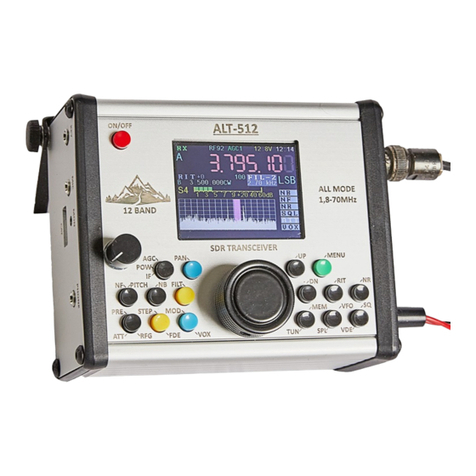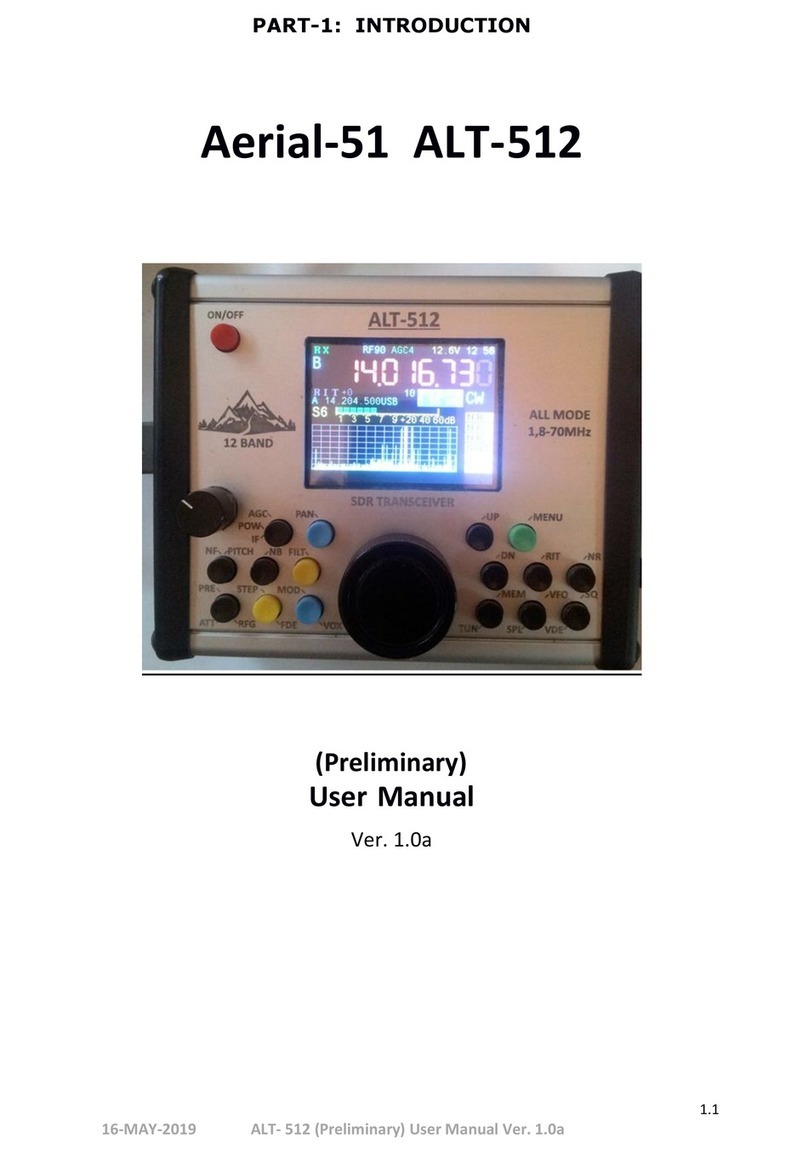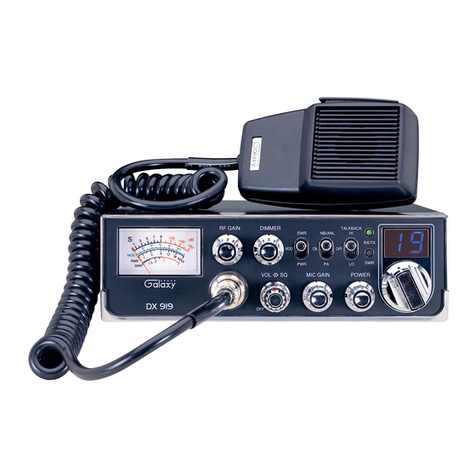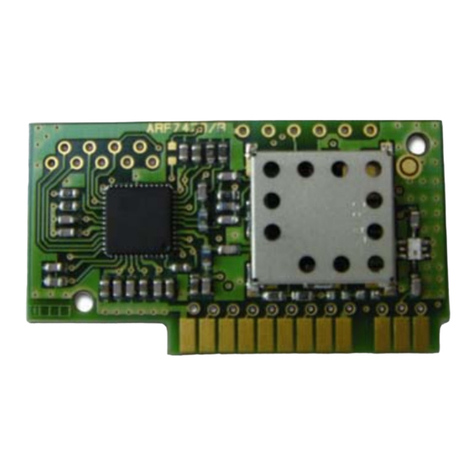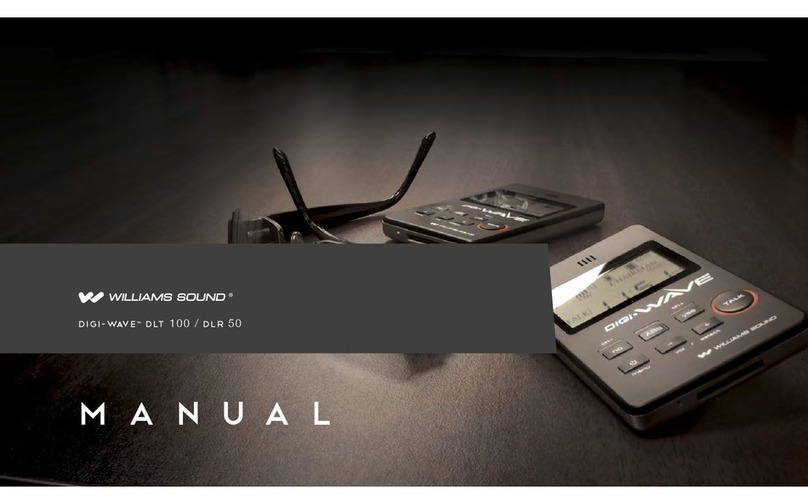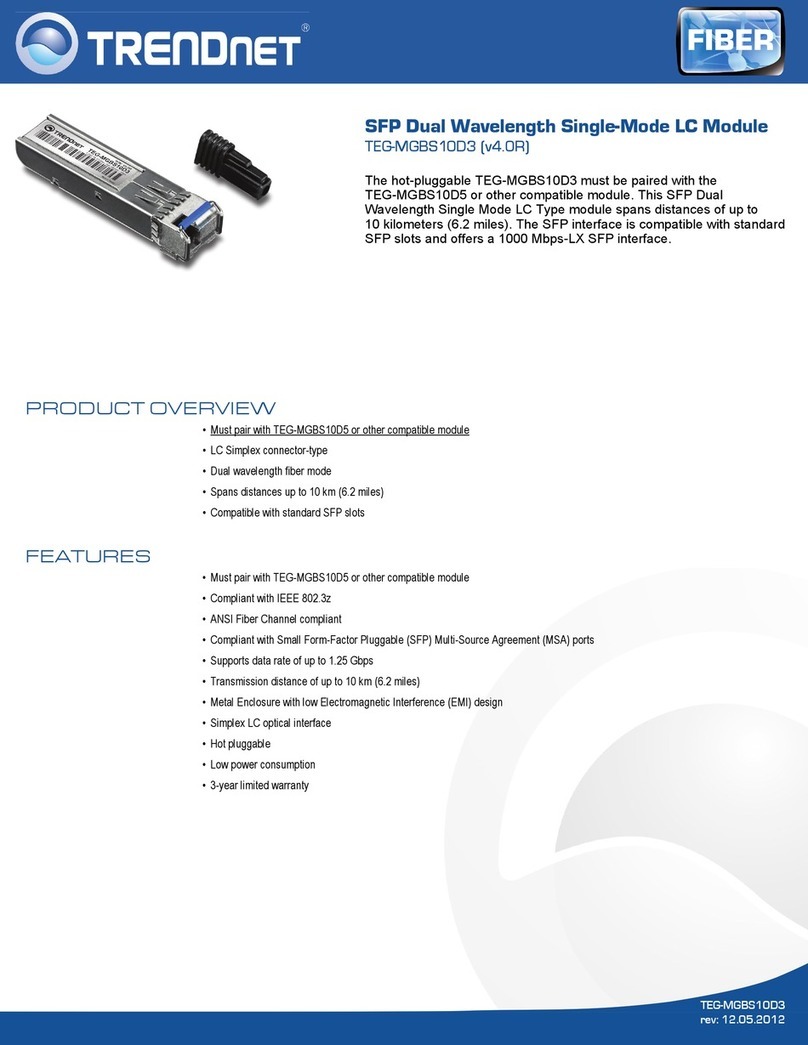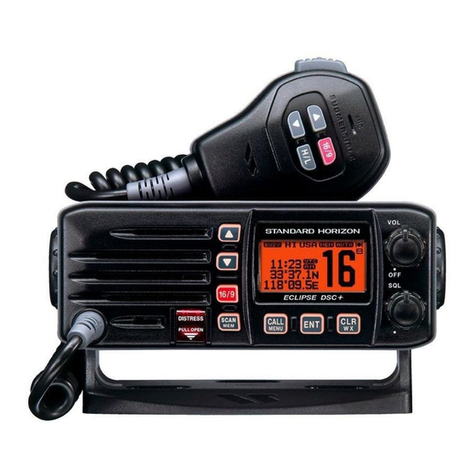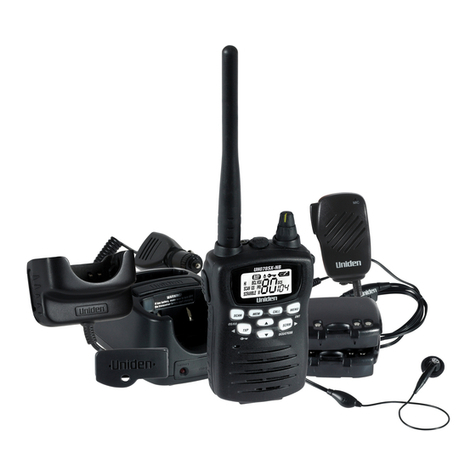Aerial-51 SKY-SDR User manual

1
SKY-SDR USER MANUAL Ver. 1.3.1 - 28-MAR-2017

2
SKY-SDR USER MANUAL Ver. 1.3.1 - 28-MAR-2017
TABLE OF CONTENTS
1. TABLE OF CONTENTS. . . . . . . . . . . . . . . . . . . . . . . . . 2
2. INTRODUCTION. . . . . . . . . . . . . . . . . . . . . . . . . . . . . 3
3. SPECIFICATIONS . . . . . . . . . . . . . . . . . . . . . . . . . . . . 4
4. ACCESSORY PACKAGE . . . . . . . . . . . . . . . . . . . . . . . 7
5. FRONT PANEL CONTROLS. . . . . . . . . . . . . . . . . . . . 8
6. SIDE PANEL CONNECTIONS . . . . . . . . . . . . . . . . . . . 10
7. OPERATION. . . . . . . . . . . . . . . . . . . . . . . . . . . . . . . . 11
•GENERAL OPERATION. . . . . . . . . . . . . . . . . . . . 11
oSPLIT FREQUENCY OPERATION. . . . . . . . . . 12
oMEMORY . . . . . . . . . . . . . . . . . . . . . . . . . . . 13
•RECEIVE OPERATION. . . . . . . . . . . . . . . . . . . . . 14
oRIT/XIT . . . . . . . . . . . . . . . . . . . . . . . . . . . . . 8
oFILTER SELECTION AND ADJUSTMENT . . . . 15
oOTHER DSP OPTIONS. . . . . . . . . . . . . . . . . . 16
oRECEIVER BANDSCOPE . . . . . . . . . . . . . . . . 17
•TRANSMIT OPERATION. . . . . . . . . . . . . . . . . . . 17
•GENERAL TX OPERATION. . . . . . . . . . . . . . . . . 18
oTX MONITOR . . . . . . . . . . . . . . . . . . . . . . . . 18
•MODE-SPECIFIC OPERATION . . . . . . . . . . . . . . 19
oSSB OPERATION. . . . . . . . . . . . . . . . . . . . . . 19
oCW OPERATION. . . . . . . . . . . . . . . . . . . . . . 19
oDIGITAL MODES OPERATION. . . . . . . . . . . 20
oRTTY OPERATION . . . . . . . . . . . . . . . . . . . . 20
oAM & FM OPERATION . . . . . . . . . . . . . . . . 20
8 SOFTWARE MENU MODE SETTINGS . . . . . . . . . . . 21
•SOFTWARE MENU QUICK GUIDE. . . . . . . . . . . 23
9SERVICE MODE . . . . . . . . . . . . . . . . . . . . . . . . . . . . . 24

3
SKY-SDR USER MANUAL Ver. 1.3.1 - 28-MAR-2017
IMPORTANT MESSAGE
Operating an Amateur Radio Transmitter/Transceiver requires an
Amateur Radio License in ALL Countries! Operating the SKY-SDR without
a valid Amateur Radio License is punishable by law in ALL Countries.
INTRODUCTION
The Aerial-51 SKY-SDR 11-Band,
All-Mode transceiver is a synthesis of
modern SDR/DSP technology and
ease of use. It sports nearly all of the
features of much higher priced SDR
transceivers, has knobs, is easy to
use and requires no computer for
operation.
The SKY-SDR comes with advanced
DSP features such as user-definable
razor-sharp filters, Noise Reduction
(NR), Noise Blanker (NB), Notch Filter
(NF) and adjustable AGC timing.
BE CAREFUL when using the
radio. A false adjustment of some
parameters may lead you to
believe the radio is broken!
RESET: If you think the radio may
be misadjusted, you may reset
most parameters simply by
entering the Service Mode, and
then immediately exiting the
Service Mode. See Page 24.
The SKY-SDR also incorporates a
BANDSCOPE which displays 24 kHz
above and below the operating
frequency. This helps find stations on
a quiet band, or locate a free spot on
a crowded band.
SKY-SDR’s5 Watt transmitter
comes with a hand mike and produces
one of the cleanest signals on the air.
It includes features such as Speech
Processor, Dual-Mode CW/CWR,
built-in Keyer supporting A/B modes
of keying and full metering of output
power and SWR. External amp
keying is available through a
dedicated RCA Phono (Cinch) jack.
The SKY-SDR has audio equalizing
for both RX and TX modes, RIT and
XIT, and of course dual VFOs. It
includes a USB CAT-Control with FTDI
decoder, and LINE IN/OUT for digital
modes.
SSB Mode requires pre-adjustment
of the speech processor and TX
Equalizer for good speech quality.
----------------
PLEASE STUDY THIS MANUAL
BEFORE BEGINNING OPERATION
Proper Operation of the SKY-
SDR requires the following
things:
•A valid Amateur Radio License
authorizing operation on the HF
Amateur Radio bands.
•A regulated power source
(power supply or battery)
supplying nominal 13.8vdc @ 2
Ampere. (Note: 10.5v minimum
to 15.0v maximum).
•A (nominal) 50 Ohm Antenna on
the band(s) of operation.
•OPTIONAL:
•Stereo Headphones (4 to 64
Ohms).
•Morse Code Straight Key or
Paddle.

4
SKY-SDR USER MANUAL Ver. 1.3.1 - 28-MAR-2017
SPECIFICATIONS
GENERAL TRANSCEIVER SPECIFICATIONS
Technology
Solid State SDR-DSP
Direct Conversion
Frequencies / Bands
1.8 MHz to 54.0 MHz
160, 80, 60, 40, 30, 20, 17,
15, 12, 10, 6m
Modes
AM, CW, DIGI, FM, LSB, USB
CAT: USB2 (FTDI Chip)
Digital Modes
JST, PSK, RTTY, SSTV, etc.
LINE IN/OUT 3.5mm Jack
Output Power
5 Watts (typical)
(fold-back protection for high
SWR)
Antenna
50 Ohms (nominal)
BNC Connection
Voltage Requirements
10.5vdc (min) to 15vdc (max)
Fuse: 3.15A, 250V, Slow
Blow
Current Drain
RX: Average 360mA
TX: Maximum 2 A
RX 40mA less with the
backlight switched off
Frequency Stability
±3 ppm
0 to 50 degrees Centigrade
Memory
100 slots (0-99)
stores freq., mode, VFO
(A/B) & other functions
Loud Speaker
1/4 Watt
Display Backlight
Always On, Always OFF, Automatic (off after 3 seconds)
Enclosure Size
12.8 x 10.7 x 5.5 cm
(excluding knobs and
connectors)
Working Size
14.7 x 10.7 x 7 cm
(including knobs and
connectors)
Weight
580 grams (20.5 oz.)
(without mic)

5
SKY-SDR USER MANUAL Ver. 1.3.1 - 28-MAR-2017
TRANSMITTER SPECIFICATIONS
Output Power
5 Watts (typical) / adjustable
(fold-back protection for
high SWR)
TX Metering
Selectable: Output Power or
SWR
Selectable: Numerical or
Bar Graph
D.C. Voltage
Metering
Numerical display
VOX
Adjustable Gain & Delay
Compressor
Adjustable 0-20dB
Reverberation
Adjustable
SSB TX Mute
Disable = Monitor / Enable = Mute
Key Type
Selectable: Automatic = Paddle / Manual = Hand-Key
Built-In Keyer
Iambic Mode A or Mode B
Menu selectable
Keyer Adjustments
Speed / Weight
Menu adjustment
CW Sequencing
Adjustable Delay
From 100ms to 5 seconds
Digi Mode Gain
Adjusts audio gain in digi mode
AMP Key (PTT JACK)
Keys External Amplifier
TX DSP FILTERS
1 Filter per Mode
SSB TX Filters
Bandwidth: 2.800 kHz
Adjustable
CW TX Filters
Bandwidth: 100 Hz
Adjustable
AM TX Filters
Bandwidth: 5.590 kHz
Adjustable
FM TX Filters
Bandwidth: 9.600 kHz
Adjustable
DIGI TX Filters
Bandwidth: 3.350 kHz
Fixed
TX Bandscope
Monitors transmitted signal

6
SKY-SDR USER MANUAL Ver. 1.3.1 - 28-MAR-2017
RECEIVER SPECIFICATIONS
Technology
Solid State SDR-DSP
Direct Conversion
Sensitivity
0.2 uV
With Preamp On
Preamp
+16 dB
Attenuator
-6 dB
Pre-Filtering
7 LPF and 7 BPF (cascaded)
160m, 80m, 60+40m,
30+20m, 17+15m,
12+10m, 6m
Spurious Response
…Rejection
IMD3: -48 dB
Current Drain
Backlight: ON / OFF
Avg. 360mA / 320mA
RX Bandscope
±24 kHz
DSP RX Filters
4 filters (most modes)
1 is user definable
push-button selection
SSB Filters (4)
4 Filters:
•3 Fixed Filters
•1 User Adjustable Filter
From 250 Hz to 3600 Hz
CW Filters (4)
From 20 Hz to 1200 Hz
AM Filters (4)
From 2.0 kHz to 9600 Hz
FM Filters (4)
From 2.0 kHz to 9600 Hz
DIGI Modes (1)
Bandwidth
Fixed: 3.35 kHz
DSP Noise
…Reduction
Adjustable Level (1 to 50) use lowest level necessary
DSP Noise Blanker
Adjustable Level (4 to 12) Adjust for minimum interference
DSP “ACE”
Automatic Carrier Eliminator, SSB mode (only),
(greater -40dB) {This is an improved Notch Filter}
S-Meter
Bar Graph or uV readout
CW Mode Selection
CW or CWReverse
Menu selectable
Squelch
Adjustable for FM & Other
Modes
0 to 100 / "0" = Off

7
SKY-SDR USER MANUAL Ver. 1.3.1 - 28-MAR-2017
ACCESSORY PACKAGE
The SKY-SDR ships with the following accessories:
Microphone: An electrets mic that
draws its power from the mic line (tip).
If you use a dynamic mic, you must
insert a 350 to 400 nF capacitor
between the mic capsule and this line.
DC Power Cable: Red (+) and Black
(-) power cable with in-line fuse holder
and coaxial power plug (2.5mm x
7mm).
Spare Fuse: (not pictured) a spare
fuse is included in the accessory
package. It is a 5mm x 20mm fuse,
3.16A, 250V Slow-Blow.
USER MANUAL
CAT CABLE: This is a standard
computer USB2 cable with type A plugs
on both ends.
2 ALLEN WRENCHES: (not shown)
LINE IN/OUT: This is a special cable
which splits the input audio and output
audio from a single common plug and
connects each to its own dedicated
plug.
All three plugs are 3.5mm phone plugs.
See pinout below:

8
SKY-SDR USER MANUAL Ver. 1.3.1 - 28-MAR-2017
FRONT PANEL CONTROLS
1. VFO-TUNING / Multi Knob;
Adjusts frequency in operation
mode.
Adjusts menu value in Menu mode.
2. AF Gain Control
3. Power ON/OFF
4. PRE/ATT –pushing button toggles
through Preamp, Attenuation, or
None.
5. STEP –selects the step size
(tuning rate) when turning the VFO
knob.
6. MODE/NF –pushing this button
toggles through the modes (USB,
CW, etc.). In SSB Mode (only):
when the [F] button is pushed,
followed by the Mode button, it
toggles the Notch Filter on or off. It
is always off in all other modes.
This is also called “ACE”.
7. FILTER –pushing this button steps
through the selection of bandwidth
filters 1, 2, 3, or 4.
8. LOCK/TX –(TUNE) In CW Mode,
Reduce Power to 25%. Then
push PTT or key CW; while
transmitting, push this button to
lock in TX Mode. Push button again
to unkey the transmitter.
9. [F].–Function Button; pushing
this button activates the 2nd layer of
functions for several button.
10. UP/NR –in operating mode,
pushing this button changes the
band to the next higher band. In
MENU mode, pushing this button
selects the next higher menu item.
Push [F] and this button to activate
the DSP Noise Reduction.
11. DOWN/NB –in operating mode,
pushing this button changes the
band to the next lower band. In
MENU mode, pushing this button
selects the next lower menu item.
If pushed after pushing [F], it
activates the DSP Noise Blanker.
12. MENU –Pushing this button enters
the software Menu Mode.
13. RIT/XIT –Pushing this button
while in RX mode enables Receive
Incremental Tuning (RIT). Disable
by pushing [RIT] again.
14. To enable XIT, you must first be
in TX mode (i.e. push PTT in SSB
or key a long dash in CW), then
push the [RIT/XIT] button. To

9
SKY-SDR USER MANUAL Ver. 1.3.1 - 28-MAR-2017
disable TX Incremental Tuning
(XIT), push [RIT].
In some menu items, this button
also is used to toggle between
multiple parts of the item (i.e.
defining filter settings, etc.).
15. MEMO –Pushing this button
enables storing and recalling
memory locations.
16. VFO/PAN –Pushing this button
toggles between VFO-A and VFO-B.
Pushing [F] and then this Button
enables turning the PAN-ADAPTER
on and off. Select with VFO knob.
17. DISPLAY –LCD display size is 43.5
x 40.9mm (1.7” x 1.6”). It has very
low power consumption.
The pictures (below) describe most
of the features which are displayed
on the SKY-SDR display.
NOTE: “IF” in the lower right
corner must ALWAYS be “on”
and normally showing. When
the Pan-Adaptor is on, the “IF”
cannot be seen but it must still
be on. If it is ever “Off”, push
[F] + [RIT/XIT].
NOTE: “IF” (Virtual Intermediate Frequency) MUST ALWAYS BE “ON”.
When the virtual IF is OFF, receiver performance is significantly degraded.
If it is ever off, press [F] and then [RIT] to switch it back on. When the
Bandscope is on, it covers the bottom line of the screen and you cannot see “IF”.

10
SKY-SDR USER MANUAL Ver. 1.3.1 - 28-MAR-2017
SIDE PANEL CONNECTIONS
Left Side Panel
KEY: The SKY-DSR accepts either a
Straight Key or Paddle. Both connect
to the 3-pole, 3.5mm key jack.
MIC: The SKY-DSR comes with a
condenser (electret) hand Microphone
using a 3.5mm phone jack. To use a
dynamic MIC, you must insert a 330 to
470 nF capacitor in series with the
+MIC line.
PHONE: The SKY-DSR accepts stereo
headphones with a 3.5mm phone jack.
Any common stereo headphones with
an impedance of 4 to 64 Ohms will
work; the lower the better.
MON / SIDETONE: Adjust sidetone
volume level (through the hole) with a
tiny screwdriver.
LINE IN/OUT: Used for connecting to
external sound card interface. See
accessories page for pinout. Audio
level is independent of volume control.
Right Side Panel
DC: Power is applied through a
2.5mm x 7mm coaxial DC power plug.
ANT: A female BNC jack accepts
nominal 50 Ohm antennas.
CAT: CAT control is via a ‘type A’USB2
connection. (FTDI Chip).
PTT: Push–To-Talk, open collector
keying circuit, used to key a linear
amplifier through an RCA phono plug.
(Also called Amp Key). Delay time is
adjustable in the software menu #4
(CW VOX).
SPKR: Loud-Speaker, automatically
mutes when you plug headphones into
the phone jack.

11
SKY-SDR USER MANUAL Ver. 1.3.1 - 28-MAR-2017
OPERATION /GENERAL
BEFORE YOU BEGIN
•Assure that your antenna is in good
working order and connected to the
radio.
•Switch ON the power supply or
connect battery leads BEFORE
switching the radio on.
•Check that the supply voltage is
within the specified working range
required for proper operation.
(+10.5 to +15.0 vdc).
•Reduce the audio gain (turn gain
control almost fully counter
clockwise).
•Turn the radio ON and observe the
dial. The Aerial-51 logo should
appear for 3 or 4 seconds, and then
the radio switches to operate mode.
GENERAL INFORMATION
The SKY-SDR has only two primary
controls: the audio gain knob and the
VFO knob.
Audio Gain Knob: This is a
mechanical control with only one
function –to control the audio output
level to the speaker or headphones.
Full Counter ClockWise (CCW) is the
lowest gain setting, full ClockWise
(CW) is the maximum gain setting. The
position of this control does not affect
the audio output level on the LINE
IN/OUT jack.
VFO Knob: The VFO knob is used for
multiple functions:
1. Changing the operating frequency.
2. Changing software menu values
when operating in Menu Mode.
3. Changing the Receive Incremental
Tuning (RIT) frequency or Transmit
Incremental tuning (XIT) when
either of these functions is enabled.
Explanation of each of the VFO
function:
1. Turning the VFO knob is the basic
means of changing the operating
frequency. Turning the knob in the
CW direction increases the
frequency, and turning it in the CCW
direction decreases the frequency.
There are two modes of tuning
operation that may be selected by
the software menu item #1
(Valcoder). Either “variable”
speed tuning (Smart Valcoder
Enabled) or “fixed” speed tuning
(Smart Valcoder Disabled) may be
selected. In variable speed tuning
mode, the rate of change of
frequencies varies with the speed of
which you turn the VFO knob.
2. Most software menu items have
variable parameters that are
adjustable with the VFO knob. For
instance in RX mode you can vary
the level for the Noise Blanker or
the Noise Reduction, etc. For TX
you can vary the level of the speech
processor or the speed of the
automatic keyer in CW, etc.
Some menu items are simply
switched (toggled) between 2 or 3

12
SKY-SDR USER MANUAL Ver. 1.3.1 - 28-MAR-2017
positions, such as selecting whether
to show Output Power or SWR in TX
mode, or whether to show S-Units
or uVolts in RX mode, etc.
For a more detailed explanation,
see the Menu Mode Settings on
page 20.
3. When RIT is enabled by pushing the
“RIT”button, rotating the VFO
knob changes only the Receive
frequency, it does not change the
Transmit frequency.
You must be in TX mode to enable
XIT. Press PTT and then press the
RIT button. Rotating the VFO knob
changes only the Transmit
frequency, it does not change the
Receive frequency.
In RIT mode, the change in
frequency when rotating the VFO
knob can be observed on the top
right of the DISPLAY, as seen
here:
………………………………………………………………………………………………………………………………………..
STATUS |------ DISPLAY ------→| COMMENTS
•RIT OFF: |RxA 13.1V LSB|
•RIT ON: |RxA 13.1V RIT * LSB| RIT = 0
•RIT ON: |RxA 13.1V RIT < LSB| RIT lower than VFO QRG
•RIT ON: |RxA 13.1V RIT > LSB| RIT higher than VFO QRG
………………………………………………………………………………………………………………………………………..
When RIT and XIT are both off,
there is nothing displayed. Turning
either one “ON” will show the “RIT”
(or “XIT”) in the space between the
voltage and the mode as shown
under DISPLAY above. The symbol
after RIT (or XIT) shows which way
the incremental tuning is moving.
<=down -or- >=up.
There is no function to re-sync the
RIT with the VFO’s frequency. If
you wish to do so, you must
manually tune it until the asterisk
(*) appears.
To exit RIT or XIT, simply push the
button again.
SPLIT FREQUENCY OPERATION
For simplicity, the button labeled
[VFO/PAN] will be referred to simply
as [VFO] and [RIT/XIT] will be
referred to as [RIT].
The SKY-SDR’s SPLIT is totally simple
to use, but somewhat different than
with other radios. Before enabling
SPLIT, you should set both VFOs where
you want them to be after SPLIT is
enabled –typically one on the RX
frequency and the other on the TX
frequency.
SPLIT Mode is entered while in RX
mode by pressing [RIT] + [VFO].
These two buttons are next to each
other so the operation takes just 1
second to execute.

13
SKY-SDR USER MANUAL Ver. 1.3.1 - 28-MAR-2017
Fundamentally, the radio has two
independent VFOs on each band and
the frequency each is tuned to before
enabling SPLIT will be its TX frequency
after entering SPLIT Mode. To toggle
between VFOs as always: simply push
[VFO].
IMPORTANT: Even though one VFO
will be on the desired RX frequency,
you will NOT use it for receiving. For
receiving you must use the VFO that is
showing the desired TX frequency and
tune it manually back to the RX
frequency.
To EXIT SPLIT at any time, simply by
push [RIT].
This will be clearer in the example
below:
SPLIT OPERATION EXAMPLE:
•“DX1DX” is calling CQ on 14.150
MHz and requesting callers “UP 5”.
•You are receiving on VFO-A.
•PRESS THE [VFO] BUTTON. The
radio switches to VFO-B.
•Tune VFO-B to 14.155 MHz (5 kHz
above DX1DX’s frequency).
•Now PRESS the [RIT] BUTTON –
as if you were normally turning on
RIT. You notice the “*” appear in
the top right of the display.
DO NOT TURN THE VFO KNOB.
•IMMEDIATELY PRESS THE [VFO]
BUTTON to switch into SPLIT Mode
displaying 14.155 MHz. THIS is
now the TX frequency. The TX is
locked on this frequency. The VFO
knob now tunes the RX frequency.
•Tune back to 14.150 MHz and
find DX1DX again. READY!
•Your radio is now working split.
Confirm by pushing the Mic’s PTT
button and watching the display.
When you transmit, the frequency
switches to 14.155 MHz. When you
release the PTT button it returns to
RX and 14.150 MHz.
•You may switch to VFO-A at any
time and you will be receiving and
transmitting on 14.150 MHz
(CAREFUL: if you transmit on VFO-
A, you are transmitting on the
frequency of DX1DX). If you tune
the VFO knob, it will change the RX
frequency but when you transmit,
you will transmit on 14.150.
To EXIT SPLIT, just push the [RIT]
button while in RX Mode.
Practice using this feature 2 or 3 times
before you need it. You will soon see
that although it is different, it is very
easy to use!
MEMORY
The SKY-SDR has 100 memory
locations, labeled from 0 to 99.
Other information such as mode,
filter bandwidth, AGC settings, etc.
is also stored together with the
frequency.
STORING DATA IN MEMORY:
•Tune the VFO to the
frequency to be stored and
make sure that other settings
such as mode, bandwidth,
AGC, etc. are as you wish to
store them.
•Press [MEMO] to switch to
Memory Mode.
•Rotate the VFO Knob to the
memory slot (0 to 99) in
which you wish to store the
data.

14
SKY-SDR USER MANUAL Ver. 1.3.1 - 28-MAR-2017
•Press [DOWN] to
download the data into the
selected memory location.
•Press [MEMO] to store the
data, exit Memory Mode, and
return to normal operation.
RETRIEVING DATA FROM
MEMORY:
•Press [MEMO] to enter
Memory Mode.
•Rotate the VFO Knob to
the memory location (0 to
99) that contains the data
you wish to retrieve.
•Press [UP] to upload the
data to the VFO.
•Press [MEMO] to exit
Memory Mode and return to
normal operation.
NOTE: Each time you power on
the radio, the first time you enter
Memory Mode, it defaults to
memory location 0.
TIP: Do not store favorite
frequencies into memory location
0. Leave 0 free and use it as a
scratch pad.
During normal operations, if you
wish to temporarily store
something to retrieve a short time
later, store it into memory location
0. That way it is easier to find the
temporary data later.
BAND SELECTION
Band selection is accomplished by
using the UP or DOWN arrows, just to
the right of the VFO knob. The band
order is:
160m|80m|60m|40m|30m|20m
|17m|15m|12m|10m|6m
With each press of a button, the radios
steps up or down by one band.
DISPLAY BACKLIGHT
Software Menu item #15 (LED
Mode): The options are: OFF, Always
ON, or automatic (off after three
seconds). When off, it saves about 40
mA of current.
RECEIVE OPERATION
MODE SELECTION
There are two groups of modes:
•CW|CWR|DIG|AM|FM|USB|LSB
(AM/FM Enabled)
•CW|CWR|DIG|USB|LSB
(AM/FM Disabled)
You can choose which group you prefer
in Menu item #16 (in Menu Mode).
NOTE: each band can and must be
adjusted separately. Selection is
stored by band. Turning AM/FM “OFF”
on the 160 through 12m enables faster
stepping through the usable modes on
these bands.
FILTER SELECTION AND
ADJUSTMENT
The SKY-SDR has 4 filters per mode in
AM/CW/FM/SSB (F1, F2, F3, & F4).

15
SKY-SDR USER MANUAL Ver. 1.3.1 - 28-MAR-2017
There is only one filter for DIGI mode
with a fixed bandwidth of 3.35 kHz.
On all other modes, F1, F2 & F3 are
fixed bandwidths and are not user
adjustable. F4 is user-adjustable to
any convenient bandwidth and may be
adjusted without exiting Operating
Mode.
The bandwidth of the selected filter is
shown in kHz on the display, preceded
by the filter number. Example:
“F1: 2.9 kHz” or “F4: 0.1 kHz”.
In CW and SSB modes you can also
change the passband center frequency
as well as the bandwidth. This is not
necessary in AM or FM.
In CW mode, this is accomplished by
setting “CW PITCH” in Menu Mode
item #2. The bandwidth of the filter
selected is then centered on that
frequency.
In SSB mode (LSB or USB), this is
accomplished by setting the Lo-Cut and
Hi-Cut frequencies; the bandwidth is
then the difference between these two
frequency, the passband center is the
determined by the Hi-Cut frequency
minus half of the passband bandwidth.
Example follows below.
F4 Filter Adjustment:
For AM/FM & CW, filter adjustment is
simple. While in operate mode:
•Select the filter F4.
•Press [F] (blue button)
•Press [Filter] (the current
bandwidth appears)
•Rotate the VFO knob to adjust
the bandwidth (CW=wider,
CCW=narrower). Changes are
heard in real-time, but not yet
saved.
•Once the desired bandwidth is
set, save the change by pressing
the “Filter” button again.
EXAMPLE-1: Say we want a 100 Hz
CW filter centered on 650 Hz:
•Select CW Mode
•Select filter “F4”
•Press [F], then press [Filter]
•Using the VFO knob, set the
bandwidth to 100.
•Set the center frequency of the
passband for the CW filter in
Menu Mode item #2 (CW
Pitch).
Push “MENU”, then using the UP
or DOWN arrows, scroll to Item
#2 (CW Pitch). Adjust the VFO
knob to 650. Press [MENU] to
exit and save settings.
The SSB F4 filter’s bandwidth and
passband are also easy to adjust.
The filter is adjusted by re-defining the
“Low Cutoff Frequency” and “High
Cutoff Frequency” of the filter’s
passband. The parameters are set as
follows:
•Bandwidth: difference between
the two frequencies (Hi Freq. –
Lo Freq.).
•Passband Center: Hi Freq.
minus half the bandwidth
frequency.
EXAMPLE-2: Say we want an SSB
filter 1.8 kHz wide, centered on 1.5
kHz:
•Select USB Mode

16
SKY-SDR USER MANUAL Ver. 1.3.1 - 28-MAR-2017
•Select filter “F4”
•Press [F], then press “Filter”
•Press [RIT] to toggle between
Lo- and Hi- adjustments –Use
VFO knob to adjust frequency.
•Set Lo-Freq. to 600 Hz ; Set Hi-
Freq. to 2.4 kHz
•Passband Center is: 2400 Hz
minus 600 Hz = 1500 Hz
Digital Modes: Most DIGI modes are
operated in DIGI Mode with a fixed
filter bandwidth of 3.35 kHz. For RTTY,
use USB Mode.
OTHER DSP OPTIONS
Noise REDUCTION <NR>: The NR is
used to help reduce the level of
received broadband noise. It is
engaged by pressing [F] and then
pressing the [UP/NR] button. The NR
should be left OFF unless absolutely
necessary, as it will slightly distort
received audio when ON.
The level of noise reduction of the NR
may be adjusted in the software menu
item #2, with a range of 1 to 100. 1 is
minimum and 100 is maximum. You
should only use as high of level as
deemed necessary. This helps keep
audio distortion to a minimum. To
deactivate the NR, press [F] and
[UP/NR] again.
NOISE BLANKER <NB>: The NB is
useful for reducing the level of short
pulse noise, such as static crashes or
pulses generated from an electric
fence. It is engaged by pressing [F]
and then pressing the [DOWN/NB]
button. The level of blanking can be
adjusted in the Software Menu item
#10, with levels ranging from 4 to 12.
In this case, 4 is maximum blanking
and 12 is minimum blanking. Always
set this level as high as possible while
still achieving the necessary blanking.
To deactivate the NB, press [F] and
[DOWN/NB] again.
NOTCH FILTER <NF>: The NF
(“ACE”) is used for eliminating
carriers/heterodynes while operating
in SSB mode (only). It does not work
in any other mode. It is activated by
first pressing the [F] button and then
pressing the [MODE] button. To
deactivate NF, press [F] and [MODE]
again.
RECEIVER SENSITIVITY
There are 3 levels of sensitivity:
NORMAL; ATTENUATION; and PRE-
AMPLIFIER. Toggle through these 3
levels by pressing the [PRE/ATT]
button. The level selected is shown in
the bottom line of the display as: “AMP”
for Preamp; “ATTN” for Attenuator; or
blank (nothing shown) when in
“NORMAL” mode.
AGC TIMING: The attack and
recovery time of the AGC is set in
the Software Menu Item #9.The
range is from 1 (slowest) to 20
(fastest). Use slower speeds for
SSB and faster speeds for CW and
digital modes.
S-METER OPTIONS
The S-Meter is only accurate
when the Pre-Amp is “ON”. The
signal strength of the received
station may be displayed in S-Units

17
SKY-SDR USER MANUAL Ver. 1.3.1 - 28-MAR-2017
on the bar-graph display, or
numerically in uVolts. The S-Meter
mode is set in the MENU Item
#11. Note: with Pre-Amp “Off”, the
S meter will read about 3 S-Units
lower than the actual signal
strength.
AUDIO OPTIONS
AUDIO EQUALIZER: The received
audio may be adjusted in three
frequency ranges: Low/Medium/High.
It is adjusted in the Software Menu
item #26 (EQ RX). Once #26 has
been selected, you may step through
the three ranges by pressing the [RIT]
button. The level is adjusted using the
VFO knob. The range is 1 to 10 with 1
deemphasizing the range (minimum)
and 10 emphasizing the range
(maximum). Adjust to suit your own
preference.
SQUELCH-FM: The squelch level for
FM is adjusted in the Software Menu
item #17. The range is 0 to 100.
When set to 0, the squelch is off. Adjust
to suit your own preference.
SQUELCH-SSB/CW: The squelch
level for SSB and CW is adjusted in the
Software Menu item #18. The range
is 0 to 100. When set to 0, the squelch
is off. Adjust to suit your own
preference.
RECEIVER BANDSCOPE: is useful for
spotting clear frequencies on a very
crowded band, or locating signals on a
quiet band. It is switched ON or OFF by
pressing [F], then the [VFO/PAN]
button. The Pan Level is adjusted in
the Software Menu item #27.
TRANSMIT OPERATION
GENERAL ADJUSTMENTS
TRANSMIT DISPLAY MODE: The
SKY-SDR can monitor Output Power or
SWR. The mode is selected in the
Software Menu item #13 (Show TX).
TRANSMIT DISPLAY METHOD: The
SKY-SDR can display the output power
or SWR on a Bar Graph or as a
numerical value. The display method
is selected in the Software Menu item
#12 (TX Meter).
TRANSMIT POWER: The output
power of the transmitter is adjusted in
Item #14 (Power TX) of the
Software Menu. The range is 10
(approx. 1W) to 100 (approx. 6W).
FOLDBACK PROTECTION: when the
SWR is high, the power is reduced to
protect the final amplifier transistors.
Above an SWR of 2:1 it reduces the
output power to 3 Watts. By 10:1 SWR
it is reduced to just 1 Watt.
TX AUDIO ADJUSTMENTS:
TX AUDIO EQUALIZER: The TX audio
may be tailored with the help of a built
in 3-band equalizer: Low, Medium, and
High frequencies. It is adjusted under
the Software Menu item #25 (EQ
TX). The bands are selected by
pressing the RIT button and the level
for each range is adjusted with the VFO
knob. The range is from 1
(deemphasize) to 10 (maximum

18
SKY-SDR USER MANUAL Ver. 1.3.1 - 28-MAR-2017
emphasis). RECOMMENDED:
Low=10, MED=6 and HIGH=6.
SPEECH COMPRESSOR: The level of
compression is set in the Software
Menu item #23 (Compress TX).
The range is from 1 (minimum) to 100
(maximum compression). Setting it to
1 effectively turns it off. In most
cases, a level of 40 to 50 is
required for the factory hand-mic.
REVERBERATER: The radio also has
a built in reverberator that enables
enhancing the transmitted audio
slightly. CARE MUST BE TAKEN when
using this feature. A very small
amount of reverberation can enhance
the signal but too much makes it
difficult to copy.
Default is “DISABLE”. Rotate the VFO
clockwise to enable and select delay
times: (40ms, 80ms, and 160ms).
Press RIT to toggle to Depth, Level, and
back to delay times. Depth and Level
may be adjusted from 1 to 7.
Before using this feature on the air, you
should experiment with the
adjustments while transmitting into a
dummy load and having a friend listen
to your signal on a nearby receiver.
TRANSMIT GAIN
Mic-Gain is fixed and optimized for the
hand Mic. Adjust compressor for best
audio level. (set about 50)
DIGI MODE GAIN is adjusted in the
Menu item #20 (Gain TX DIG).
TX MONITOR: You may monitor your
own TX audio in headphones while
adjusting the audio settings. This is
enabled in the Software Menu item 19
(SSB TX MUTE). “Enable” mutes
(turns off) this feature. “Disable” turns
it on.
MODE-SPECIFIC OPERATION
SINGLE SIDEBAND OPERATION
For information on adjusting Mic Gain,
Audio Equalizer, Speech Processor,
Reverberator, and TX Monitor, see
OPERATION TRANSMIT –GENERAL
ADJUSTMENTS on pages 16 and 17.
VOX-GAIN: The level of VOX gain is
adjusted in the Software Menu item
#21 (Voice VOX Level). Here you
can adjust the sensitivity at which the
VOX switches to TX Mode. The range
is from 10 (most sensitive) to 100
(least sensitive).
VOX-DELAY: The VOX delay or “hang
time” is adjusted in the Software
Menu item #22 (Voice VOX).
BANDSCOPE: The TX Bandscope
works independently of the RX
Bandscope turning on the RX scope
does not automatically turn the TX
Bandscope. Enable TX Bandscope by
depressing the PTT button on the MIC,
then press [F] and then [VFO/PAN].
The Bandscope display remains empty
until you speak into the mic.
Adjust Pan Level in Software Menu
item #27.
CW OPERATION
CW MODES
There are two modes of CW operation,
Normal (CW) and Reverse (CWR).
There is no agreed standard on which
mode to use. In some cases where

19
SKY-SDR USER MANUAL Ver. 1.3.1 - 28-MAR-2017
there is strong QRM from one side, you
will get better reception by switching to
the opposite mode. The CW Mode is
selected in the Software Menu item
#8 (Reverse CW Key).
SIDETONE LEVEL
The sidetone level adjustment is a
mechanical adjustment. The level is
adjusted using a small screw driver
through a hole on the left side panel.
See “Side Panel Connections” (and
adjustments) on page 10.
The SKY-SDR has several features for
CW Mode.In order to enable
transmitting in CW, you must select a
delay time in Software Menu item #3
(CW VOX).Default is “Disabled.” The
minimum delay is 100 ms. The
maximum is 5 seconds.
When using the radio with an external
amplifier, 100 ms is OK with many
newer amps. When using with amps
that have a slow open-frame T/R relay
(i.e. most Ameritron amplifiers), you
will need 200 or 300 ms to prevent the
amp’s slow T/R relay from trying to
follow the keying with every dit or dah.
CW-PITCH: The CW Pitch control sets
the frequency of the center of the
bandpass of the filters; thus it defines
the frequency which will sound the
loudest when tuning across CW
stations. When you adjust the CW
Pitch, it automatically adjusts the
transmit offset frequency such that you
will be zero-beat with the other station
when you are listening to a tone with
the pitch you set.
EXAMPLE: If you set the Pitch for 700
Hz and listen to a 700 Hz tone, you will
be zero beat. If you listen at 600 Hz,
you will be 100 Hz off frequency.
CW KEY SELECTION: The SKY-SDR
will operate with a simple straight key,
external keyer, or using its own built-in
iambic keyer.
For operation with a straight key, wire
the 3.5mm Phone plug as shown on
page 10 on the left (KEY).
For operation with an external keyer,
connect the keying line using a 3.5mm
Phone plug wired just like the straight
key.
For operation with the built-in iambic
keyer, wire the paddle as shown on
page 10 on the left (PAD).
BUILT-IN IAMBIC KEYER:
The built-in keyer has several Software
Menu adjustments:
•Iambic Mode –(Software Menu
item #6). Toggles the built-in
keyer between Mode A and Mode
B. In Mode A when releasing the
paddle, the keyer completes the
element being sent. In Mode B
the keyer sends an additional
element opposite to the one being
sent when the paddle was
released. Different users have
different preferences. If you are
not already familiar with Mode B,
you should select Mode A.
•CW [Keying] Speed - (Software
Menu item #5). Adjusts keying
speed of the keyer between 5 and
50 wpm. The change takes place
after you exit the Menu Mode.
•Weight –(Software Menu item
#7). This adjusts the dot-to-dash
ratio. Default is 3:1. Other

20
SKY-SDR USER MANUAL Ver. 1.3.1 - 28-MAR-2017
selections are: 2:1, 2.5:1, 3:1,
3.5:1, 4:1, and 4.5:1.
•Reverse CW Key –(Software
Menu item #8). This feature
enables the operator to quickly
reverse the dit and dah sides of the
paddle. This is convenient when
one OP is left-handed and the other
OP is right-handed.
DIGI MODES OPERATION
Most modern DIGI Modes should be run
with the radio set to DIGI MODES.
(Exception: RTTY). Defining how to set
up DIGI Modes is beyond the scope of
this manual. In general The only
adjustment is the TX audio gain which
is adjustable in Software Menu item
#20 (Gain TX DIGI).
RTTY OPERATION
RTTY is normally run in USB mode
which enables it to take advantage of
the radio’s narrow filters. When
running typical 170 Hz shift, you can
use a bandwidth of 500 Hz (normal) or
250 Hz on a very crowded band. You
must use filter F4 for this and adjust it
manually. See example 3 on page 14.
AM/FM MODE OPERATION
In order to operate AM or FM Mode, you
must first enable AM/FM Mode in the
Software Menu item #16.
Use same speech adjustments in AM or
FM Mode as described in SINGLE
SIDEBAND Mode.
WARNING: Do not use the Speech
Compressor in FM Mode.
Table of contents
Other Aerial-51 Transceiver manuals
Popular Transceiver manuals by other brands

Enforcement Technology Group
Enforcement Technology Group CONCEALED COMMUNICATOR operating manual
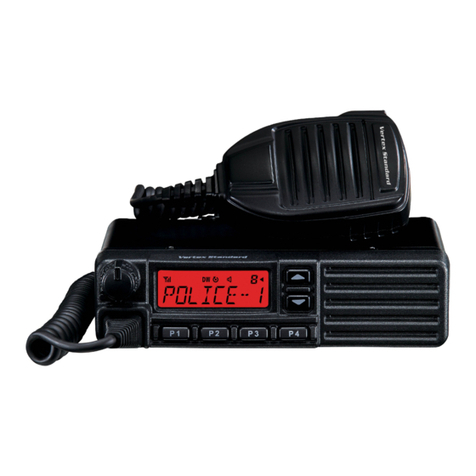
Vertex
Vertex VX-2100 series Service manual
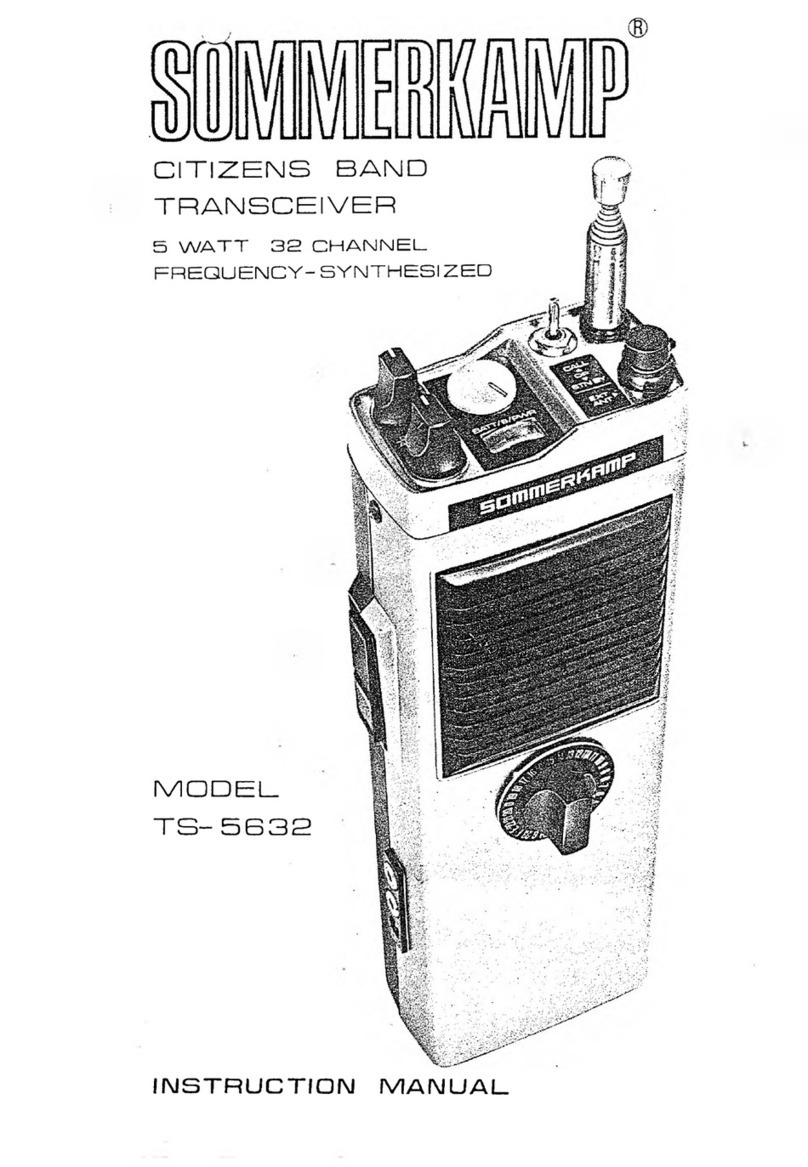
Sommerkamp
Sommerkamp TS- 5632 instruction manual

TIL
TIL TDFM-136B Quick reference guide
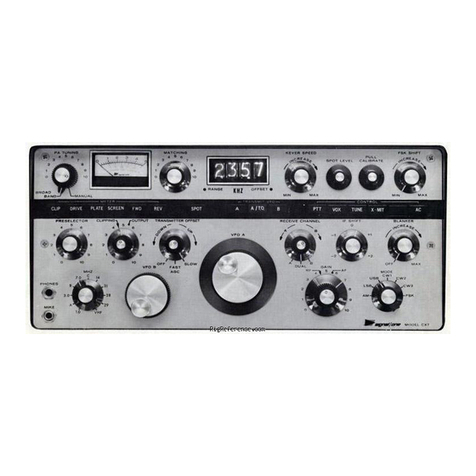
signal one
signal one CX7 Installation Adjustment & Operating Notes
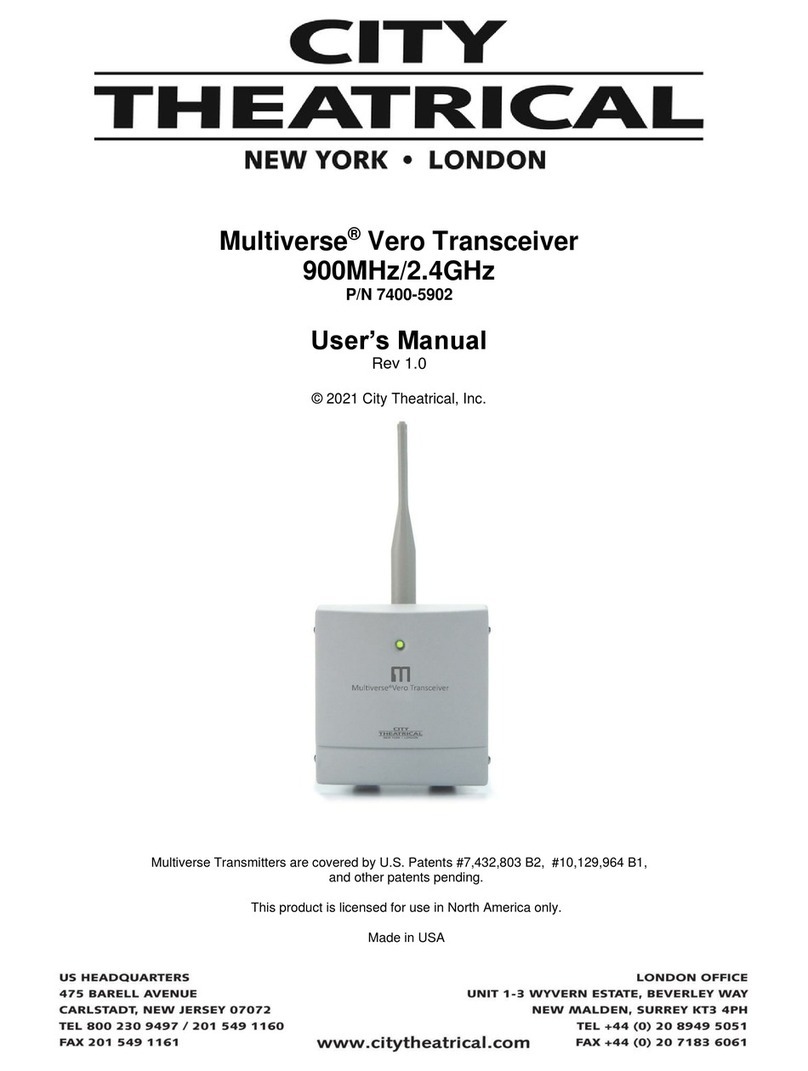
City Theatrical
City Theatrical Multiverse Vero user manual
